ShodhKosh: Journal of Visual and Performing ArtsISSN (Online): 2582-7472
|
|
Exploring the Significance of Historic Gardens in Context to Cultural Diversity: The Case of the Royal Gardens of Punjab
Mona Sood 1![]()
![]() ,
Harveen Bhandari 2
,
Harveen Bhandari 2![]()
![]()
1 Research
Scholar at Chitkara School of Planning & Architecture, Chitkara University,
Punjab, India and Professor at Lovely School of Architecture and Design, Lovely
Professional University, Punjab, India
2 Professor & Dean, Chitkara School of Planning & Architecture, Chitkara University, Punjab, India
|
|
ABSTRACT |
||
|
Historic
gardens are a precious component of our cultural heritage and a valuable
resource for understanding the past. They are tangible reflections of a
society's values, beliefs, and practices offering glimpses into the aesthetic
preferences, horticultural practices, and social values of bygone eras. These
gardens often reflect the fusion of different cultural influences, acting as
a visual tapestry of human creativity and ingenuity. To highlight the
significance of historic gardens with regard to cultural diversity, this
study examines the historical, cultural, botanical and architectural aspect
of five famous royal gardens of Punjab that were originally created as
private retreats of the Monarchs but now have been transformed into public
spaces. Drawing upon archival research, scholarly literature, and site
visits, the study delves into the architecture, symbolism, and historical
context of each garden, revealing their unique cultural expressions. The
argument put forth in the paper is that historic gardens are not just
physical spaces but cultural artifacts that serve as a testament to the rich
cultural diversity of the region, exposing visitors to a plethora of
different artistic and cultural influences. This research highlights that
historic gardens significantly contribute to cultural diversity and further
facilitate cultural exchange and cultural education. The study further emphasizes the importance
of valuing, preserving and valorizing historic gardens, not only for their
continued relevance but for fostering cultural sustainability and enriching
our collective heritage. |
|||
|
Received 29 June 2023 Accepted 19 November 2023 Published 21 November 2023 Corresponding Author Mona Sood
mmsood19@gmail.com DOI 10.29121/shodhkosh.v4.i2CDSDAD.2023.597 Funding: This research
received no specific grant from any funding agency in the public, commercial,
or not-for-profit sectors. Copyright: © 2023 The
Author(s). This work is licensed under a Creative Commons
Attribution 4.0 International License. With the
license CC-BY, authors retain the copyright, allowing anyone to download,
reuse, re-print, modify, distribute, and/or copy their contribution. The work
must be properly attributed to its author.
|
|||
|
Keywords: Historic Gardens, Cultural Heritage, Cultural
Diversity, Architecture, Royal Gardens |
|||
1. INTRODUCTION
Historic
gardens, characterized as ‘designed
landscapes’ by World Heritage Committee
under the broader category of “cultural
landscapes” UNESCO (2021), are a prominent
part of a nation’s precious cultural and natural heritage Singh (2021). They are a remarkable expression of human creativity, blending art, culture and
nature in a synergistic manner Athanasiadou (2019). The Florence Charter (1982) defines
historic garden as an architectural and horticultural composition of public
interest both from historical as well as artistic perspective. It delineates
historic gardens as ‘living monuments’ and irreplaceable heritage sites that
are testimony to a specific culture, a style, an era, and the artistic endeavor
of the creator. Since the ancient times, gardens have
been an integral and indispensable part of different aspects of human life, offering valuable insights into the deep and
inspirational kinship between mankind and nature Babnik (2020). With the growth of
cities and urban life, spaces were culled from natural scape and manipulated in
different garden styles and design, reflecting the unique ideologies, culture,
aesthetic preferences, identity and lifestyle of different communities or societies
Dasgupta (2016). Through their
evolution across different historical periods, gardens accrue a range of
cultural, social, historical, environmental, architectural, botanical and
aesthetic values that earmark them as meaningful spaces and define their
statement of significance ICOMOS. (2017); Singh (2021). Currently, 22
historic parks and gardens across the globe, owing to their outstanding value
to humanity, have attained a prestigious status in UNESCO’s World Heritage
list. Simultaneously, numerous imperial gardens worldwide have been
transformed into public parks to cater to
the social needs and demands of urban residents Paraskevopoulou et al. (2020).
While these
gardens
may not garner international or national recognition, their local significance
is profound Li and Huang (2022) as they embody
rich heritage values, serve as prominent recreational and touristic resources,
and above all, reflect the unique image and identity of the respective regions Silva and Carvalho (2022). Protection,
conservation and management of historic gardens is of paramount importance are
regulated by ratified world conventions and charters as well as legislative
frameworks developed by national authorities of respective countries Dreija (2012).
2. Historic Gardens as Significant Repositories of Cultural Diversity
“Culture takes
diverse forms across time and space. This diversity is embodied in the
uniqueness and plurality of the identities of the groups and societies making
up humankind. As a source of exchange, innovation and creativity, cultural
diversity is as necessary for humankind as biodiversity is for nature. In this
sense, it is the common heritage of humanity and should be recognized and
affirmed for the benefit of present and future generations” UNESCO. (2001)
Cultural diversity refers to the coexistence of multiple
cultural groups within a society, characterized by variations in beliefs,
values, practices, and traditions. It recognizes and embraces the unique
identities and expressions of different communities. Cultural diversity is
vital as it promotes inclusivity, fostering a society where diverse
perspectives are valued, understood, and appreciated. It enhances social
cohesion, encourages dialogue, and enriches individuals' experiences by
enabling the exchange of ideas and the celebration of human differences. Within
this framework, historic gardens hold immense significance as they serve as
valuable repositories of cultural diversity. They are tangible reflections of a
society's cultural values, beliefs, and practices, providing a vivid display of
the ingenuity, ideologies, aesthetic sensibilities, and horticultural expertise
of their creators across different historical periods Grant
(2013); Singh
(2021); Silva
and Carvalho (2022) From the medieval
cloister garden, reflecting Christian theology, to the formal Persian Gardens,
capturing the concept of paradise on Earth, to the serene and contemplative
Japanese Gardens, expressing Zen philosophy, each era's gardens were shaped by prevailing values and
philosophical or religious principles Turner,
(2005) Gardens often embody the prevailing architectural styles and
design philosophies of their respective eras, serving as cultural artifacts and
testaments to the prevailing artistic and societal trends Cazzani
et al. (2022). Through their
intricate designs and thoughtful arrangements, they demonstrate the artistic
prowess and imaginative visions of those who conceived them. For instance, the
Renaissance gardens, with their harmonious design principles, embody the
revival of humanism and artistic excellence; whereas the extravagant and
theatrical Baroque gardens, like Versailles, symbolize the opulence and
authority of the monarchy; Neo-classical gardens reflect the rationalism of the
Enlightenment, while romantic and picturesque English landscape gardens evoke a
sense of natural beauty Grant
(2013). Hence, these
remarkable spaces represent a unique expression of cultural values, showcase
the rich tapestry of human creativity and demonstrate the dynamic relationship
between humanity and its environment. They remain a memento of the centuries past with
their invariable style and character reflecting their times despite changes in
urban and rural environments over time Hodor et al. (2021). Exploring these
gardens allows us to appreciate the myriad ways cultures have interacted with
nature, shaping our identity, cultural diversity and collective heritage.
3. Purpose of the Study
This
paper is an attempt to highlight the rich and multifaceted significance of
historic gardens in the context of cultural diversity. It examines the
historical, cultural, and architectural aspects of royal gardens of Punjab that
were originally created as private retreats of the Monarchs but are now
actively used by the public and are also major tourist attractions of their
respective regions. Drawing upon archival research, scholarly literature, and
site visits, the study delves into the architectural elements, symbolism, and
historical context of each garden, revealing their unique cultural expressions
and the influences that shaped their development.
4. Unveiling the Cultural Diversity of Historic Gardens in Punjab
Punjab,
a region rich in history and cultural diversity, is home to several noteworthy
historic gardens that hold immense significance as cultural heritage sites.
This research paper examines 5 famous historic gardens of Punjab, including Aam
Khas Bagh Sirhind, Ram Bagh Amritsar, Shalimar Bagh Kapurthala, Baradari Garden
Patiala, and Banasar Bagh Sangrur, to explore the cultural diversity manifested
through their design, features, and historical significance.
4.1. Aam Khas Bagh, Sirhind
Aam
Khas Bagh, a 16th-century Mughal- era garden in Sirhind, was initially
constructed as a highway inn or resting place along the historic Grand Trunk
Road, bearing the stamp of three prominent Mughal emperors: Akbar, Jahangir,
and Shah Jahan Parihar (2006). This
exquisite garden complex was divided into two sections: the ‘Aam’, open for
public use, and the ‘Khas’, exclusively reserved for the Royalty. Its
architectural composition, influenced by the formal garden tradition of Central
Asia and Persia, is marked by notable structures like the Sheesh Mahal, Daulat
Khana-e-Khaas (private palace), Mubarik (lattice window), Khabgah (sleeping
apartments), Mehiabi Chabutara (moonlit platform) and a hamam (traditional
bathhouse) equipped with unique water heating methods Figure 1. The garden was renowned for its efficient air
conditioning system known as "Sarad Khana." and featured an ensemble
of tanks, water channels and fountains, water being drawn from a huge tank on
the southern side of the city and circulated through underground conduits Parihar (2006). Sheesh Mahal
with curved roof and the domed pavilions surmounted on octagonal bastions at
corners of the enclosure wall feature distinct cusped arches, reflecting the
exquisite architectural style prominent during the Shah Jahan period. The integration
of pointed arches in alcoves, entrance gateways and openings, typical of
Islamic architectural style, enhances the aesthetic appeal of this garden.
Figure 1


|
Figure 1 Front view of Sheesh Mahal and Plan Section of Hammam in Aam Khas Bagh Source
Mahn
and Murphy (2018)
Source Parihar
(2006) |
The
surviving structures at Aam Khas Bagh bear traces of various ornamental styles
that once adorned these magnificent buildings. For instance, parts of the
ceilings in Hammam and Sarad Khana display intricate stalactite formations with
stunning star patterns; faint remnants of painted designs can still be observed
on the walls of Daulat Khana-I Khas and Sarad Khana and the glazed tiles that
once decorated the domes of Sheesh Mahal remain subtly visible. The sprawling
complex also encompasses an extensive 11-acre orchard, housing mature mango,
pear, apricot, beri, laughat, leechi, and guava trees, some of which have
flourished for over 70 years.
Owing
to its historical and cultural significance, the garden has been declared as a
National monument by the Government of India. The garden has lost its original
glory, but the dilapidated buildings inside the complex speak volumes about the
past opulence and grandeur of this remarkable monument. As part of the renowned
Shaheedi Jor Mela held at Fatehgarh Sahib, a captivating light and sound
program is presented to visitors at night within the Aam Khas Bagh, showcasing
the history of Sirhind and the martyrdom of the younger sons of Guru Gobind
Singh through a compelling theatrical performance.
4.2. Ram Bagh, Amritsar
Ram
Bagh, located in Amritsar, was built in 1818 AD, as a summer retreat for
Maharaja Ranjit Singh, the legendary Sikh ruler. Spanning across an expansive
84 acres, this significant heritage site houses a royal palace, magnificent
gates, and many other elegant structures including the hammam, watchtowers, and
pavilions Malhotra (2013). The garden's
original design was based on the concept of Mughal charbagh (a Persian style
quadripartite garden layout), with centrally aligned water channels and
fountains Figure 2 making it an
important example of the 19th century Sikh provincial garden-palace
complex Singh (2021). Rambagh
complex has been built using features and embellishments from a broad spectrum
of historical periods and architectural styles, which underscore the maharaja’s
belief in the inclusivity of all traditions Rai (2021).
Figure
2

|
Figure 2 Original Layout of the Historic Rambagh Garden, an
Adaptation of the Mughal Char Bagh Concept Source Rai (2021) |
Summer
palace, located at the intersection of the east-west and north-south axis, is
the most remarkable monument within the complex. It is a symmetrically planned
double-storied structure with subterranean chambers for use in summers. The architecture of this palace is a
confluence of Mughal, Rajput and Sikh styles featuring prominent elements such
as multifoil cusped arches, pilasters, bracket-supported eaves and jharokhas
topped by a ribbed semi-dome Figure 3. Remnants of
wall paintings in a single chamber on the terrace floor and several rooms
housing the highly decorative wooden polychrome ‘khatamband’ ceilings reveal the original richness of surface
embellishments in the palace building Rai (2021).
Figure
3

|
Figure 3 Elevations of Summer Palace that blends elements of Mughal, Rajput and Sikh Architecture Source Malhotra (2013) |
After
the Anglo – Sikh war, Rambagh garden came into the possession of Britishers who
transformed it to a great extent and therefore a distinct layer of colonial
intervention can be witnessed in the complex Malhotra (2013). A circular
road was integrated within the historic core and three clubs were established
amidst the garden to cater to the European population residing in the city. In
spite of the fact that Rambagh has lost much of its original identity, spatial
character and glory due to the transformative layers of development, the garden
is still one of its types amongst the royal gardens of the Sikh kingdom and
holds immense cultural significance. It is a unique example of the confluence
of Persian principles with the Sikh architectural traditions and is also valued for the botanical
collections it possesses Malhotra (2013). Owing to its historical, cultural and
architectural value, this garden is the only historic site in the city that has
been declared as a ‘protected monument’ under Archaeological Survey of India Singh (2021).
4.3. Shalimar Bagh, Kapurthala
Figure 4

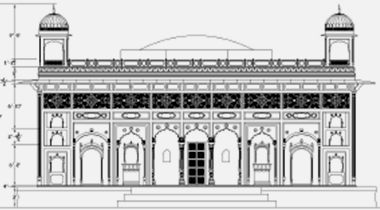
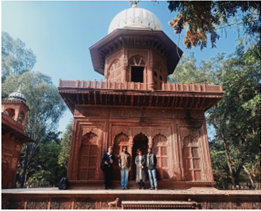
|
Figure 4 Magnificent Structures within the Premises of the Historic Shalimar Bagh Source Lovely
School of Architecture and Design, Lovely Professional University, Punjab |
Shalimar Bagh ia a significant historic garden in Kapurthala, which has been one of the pioneer princely states in the Punjab region. It was created as a pleasure garden during the reign of Maharaja Fateh Singh Ahluwalia and later Maharaja Jagatjit Singh made significant contributions to its development Kanta (2011). The garden houses magnificent structures built in red sandstone such as the Baradari, a pavilion and Shahi Samadhs (royal cenotaphs) which are basically chambers that house memorials of erstwhile rulers of the city Figure 4. These edifices showcase a strong Mughal influence, incorporating several distinctive features such as multifoil cusped arches; eaves supported by ornate brackets; jali work characterized by intricate geometric patterns; decorative parapets, fluted domes and chhatris. The chambers display exquisite engraving in red sandstone, reminiscent of the fine craftsmanship seen in royal Mughal buildings. Three separate single chhatris had been constructed towards the northern side of these buildings for the tombs of the Maharanis of the royal family Kanta (2011).
Baradari
The
entrance gateway is a prominent feature characterized by a large semi-circular
arched opening flanked by ornamental pillars. It is further enhanced by a
decorative entablature, reflecting the influence of European architectural
style. Thus, the garden exemplifies the Indo-Saracenic architectural style that
emerged during the 19th century in the Indian subcontinent under British
colonial rule, representing a harmonious fusion of Indian, Islamic and European
architectural elements.
The
garden was designed with a set of water canals and ornate fountains while the
interiors of the built structures were tastefully decorated with chandeliers,
paintings and mirrors brought from Halb (Allipo in Syria) and China Kanta
(2011). All kinds of rare fruit trees and flower
plants were planted in the garden that provided picturesque settings to the
royal structures. It was in this garden that the tradition of
Basant Mela (or Spring Festival) was first started by Maharaja Jagatjit Singh
where general public was encouraged to participate in range of events or
activities like kite flying, acrobatics, wrestling and poetry. These
festivities traditionally took place in an open court within the Baradari. Even
to this day, the tradition of Basant Mela continues to thrive, with an annual
celebration organized in the garden.
4.4. Baradari Garden, Patiala
Baradari
Garden in Patiala was planned as a palace garden in 1876 under the patronage of
Maharaja Rajinder Singh in 1868 Singh (2021). At the heart
of this magnificent complex lies a rectangular Sikh-Mughal-style pavilion,
known as the baradari, which not only lends its name to the garden but also
serves as its focal point. The Baradari Palace or the Rajinder Kothi is a resplendent
white, colonnaded building that gracefully envelops this open pavilion and is
adorned with semi circular arches, reflecting the Colonial architectural
influence Figure 5. The Palace
stands as an exquisite testament to architectural fusion, harmoniously blending
elements of Rajput, Mughal, and Colonial styles. The garden complex
encompasses a series of smaller garden spaces, meticulously designed in the
English picturesque style, featuring numerous elements reminiscent of
19th-century public parks in England, such as a fern house, statues, sculpted
fountains at strategic points and curved pathways Singh (2021).
Figure 5
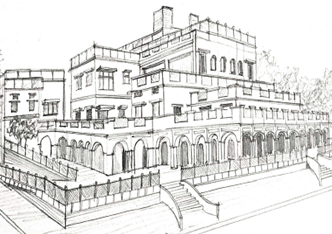
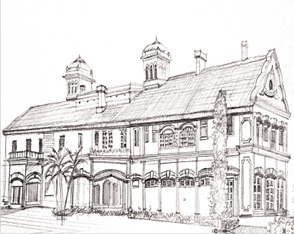
|
Figure 5 Rajinder Kothi and Maharani Club Amidst the
Baradari Gardens Source
Sketches by the Author (Mona Sood) |
In
addition to the palace, the garden is adorned with several other remarkable
buildings constructed in the colonial architectural style. These include the
Maharani club Figure 5, a cricket
stadium that stands as a testament to the Maharaja’s love for sports and an
elegant church, showcasing the cultural and religious diversity of the area. This extravagant
garden is remarkable for its rich collection of rare shrubs and trees. Maharaja
Rajindra Singh was a lover of nature and beauty; he collected the rare
varieties of saplings, floral plants, shrubs and fruit trees from every corner
of the country and cultivated them in this garden. The garden has served
as a venue for many cultural events, exhibitions, and public gatherings,
revealing its deep rooted historical and cultural significance.
4.5. Banasar Bagh, Sangrur
The
rulers of the princely state of Jind, established a splendid garden known as
'Banasar' during 18th century in the capital city of Sangrur (IDIPT,
2019). The name is derived from the garden's design, which placed emphasis on
the meticulous arrangement of trees ('Ban') and the construction of a tank
('Sar)'. During the mid-19th century, Maharaja Raghbir Singh, enclosed the
garden with a robust rampart and constructed several magnificent buildings
within its boundaries Naresh (2013). Notable among
these structures are the Diwan Khana, the Kothi, marble Baradari, and the
entrance gate to the baradari embellished with small marble kiosks. The
buildings embody a remarkable fusion of Mughal, Rajput, and Colonial
architectural styles, incorporating a plethora of distinctive elements,
showcasing the artistic sensibilities of the era.
The
architectural design of Diwan Khana Figure 6 skillfully
combines Rajput and British Colonial influences, featuring multifoil and
semi-circular arches, minarets ornate with floral decorations and topped by
chhatris, decorative parapets and railings, cornices, and a small pavilion
adorned with foliated arches and hemispherical domes; showcasing exquisite
craftsmanship of the time. Additionally, small domical structures and peacock
motifs further enhance the beauty and uniqueness of the building.
Figure
6

|
Figure 6 Front View of Diwan Khana Source Documentation
Study by Students of Architecture Department, Guru Nanak Dev University,
Punjab |
Figure
7
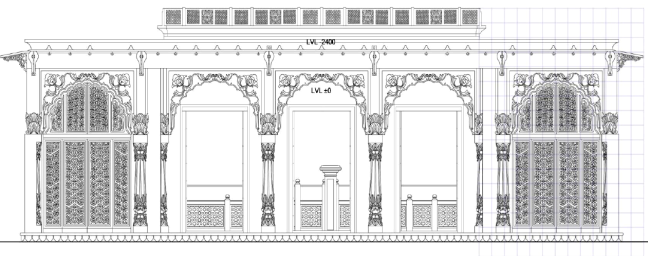
|
Figure 7 Marble
Baradari Source Documentation
Study by Students of Architecture Department, Guru Nanak Dev University,
Punjab |
The
marble baradari, a pavilion, Figure 7 features a
central hall surrounded by foliated arched openings, and it is further enhanced
by the presence of a large marble water tank encircling it. The intricate jali
work, decorative parapet panels, marble inlay work and the eaves supported by
brackets, add a touch of architectural elegance and ornamental charm to the
baradari. It boasts kiosks on all four sides, each surmounted by fluted domes.
The
erstwhile rulers adorned the garden with rare trees and plant species in the
garden and would often spend their summers here, enjoying the beauty and
serenity of their surroundings. Hence, Banasar Bagh represents the rich
cultural heritage of the Jind state and serves as a reminder of its
architectural and horticultural achievements.
5. Findings and Discussion
The
study of Royal Gardens of Punjab reveals their significant importance as
repositories of cultural and natural heritage of the region. They offer a
glimpse into the rich tapestry of Punjab’s culture, traditions and beliefs,
reflecting the cultural diversity of the region in various ways:
Garden Design: The gardens
exhibit diverse design styles influenced by various historical periods and
cultural traditions. While some resemble typical Mughal-style gardens with
symmetrical layouts and water features, others have more informal designs
inspired by English picturesque style.
Historical
Significance:
Punjab's royal gardens have played a significant role in the region's history.
They are associated with famous rulers and offer valuable insights into the
distinctive lifestyle, ideologies and aesthetic preferences of the creators.
These connections add depth to the cultural narrative of the gardens.
Architectural
Diversity:
The gardens showcase a fusion of different art and architectural styles from
Sikh and Rajput to Mughal and Colonial styles, reflecting the cultural
amalgamation and historical transitions that Punjab has experienced over the
centuries.
Plant Diversity: These gardens
are adorned with a wide range of native and exotic plant species. The rich
variety of plants reflects the horticultural knowledge and preferences of
various cultures, emphasizing the connection between biodiversity and cultural
diversity.
Cultural
Symbolism:
Many features within these Royal gardens, such as fountains, specific plants,
pavilions, sculptures paintings etc. are linked to distinct eras, embodying
cultural meanings and significance.
Events and
Festivities:
Throughout history, these gardens have served as venues for royal gatherings,
ceremonies, and festivities. Even today, they continue they continue this
legacy by hosting cultural events, performances, and celebrations. These
occasions serve as a platform for showcasing the region's rich and diverse
cultural traditions, including music, dance, cuisine, and more, facilitating
cross-cultural interactions and the exchange of ideas
The
cultural diversity in Royal gardens offers educational opportunities for
visitors to learn about Punjab's vibrant past and rich culture. They also
attract tourists from around the world, facilitating them to immerse themselves
in diverse cultural experiences; thereby promoting cultural exchange and
economic benefits for the region.
6. Conclusion
Through
a comprehensive analysis of the multifarious aspects of the Royal Gardens of
Punjab, this study brings to light the value and significance of historic
gardens within the context of cultural diversity. The research provides
insights into the role of historic gardens in preserving, showcasing and
promoting the region’s history and culture. The paper highlights that historic
gardens are not merely aesthetically pleasing landscapes, but cultural
artefacts serving as testaments to their region’s growth and development across
different historical periods. These remnants of the past, with their diverse
cultural expressions, architectural styles, botanical compositions and
historical narratives give an account of the cultural values, aesthetic
sensibilities, lifestyle and traditions of different societies that created
them. The research also underscores the benefits of cultural diversity in
historic gardens by shedding light on how it enriches their historical,
cultural, aesthetic, educational and economical value. By fostering a deeper
understanding and respect for different traditions and cultures, historic
gardens contribute to the sustainable development of communities and societies,
instilling a sense of cultural identity and continuity.
In
this light, it becomes increasingly clear that historic gardens are not mere
relics of the past the study but rather integral components of a nation’s
cultural heritage, serving as bridges between generations. This study concludes
that valuing, preserving and valorizing these gardens is of paramount
importance, not only for their continued relevance but also for promoting
cultural diversity, fostering cultural sustainability and enriching our
collective heritage.
The
research contributes to the field of cultural studies by providing insights
into the role of historic gardens in preserving and showcasing cultural
diversity. It adds depth to the understanding of how cultural diversity is
promoted and sustained through tangible aspects. It also synthesizes various
aspects like history, culture, botany, and architecture, providing a holistic
perspective. The study adds to existing literature by offering a focused
examination of the Royal Gardens of Punjab, which have been less explored in
academic literature.
The
research offers practical applications in heritage conservation efforts,
tourism promotion and cultural education programs. It can provide valuable
information to decision-makers and practitioners regarding preservation and
utilization of these sites for cultural enrichment. The findings can inform
local governments and tourism authorities about the potential of historic
gardens as tourist attractions. Promoting these sites can boost tourism and
stimulate the local economy.
CONFLICT OF INTERESTS
None.
ACKNOWLEDGMENTS
Data collection and preliminary analysis for this research were conducted using documentation prepared by Postgraduate students of Lovely School of Architecture and Design, Lovely Professional University, Phagwara, Punjab and Undergraduate students of the Architecture Department, Guru Nanak Dev University, Amritsar, Punjab. We would like to express our gratitude to the students who contributed to the documentation, as their efforts have been instrumental in the completion of this research.
REFERENCES
Athanasiadou,
E. (2019). "Historic Gardens and Parks Worldwide and in Greece:
Principles of Acknowledgement, Conservation, Restoration and Management"
Heritage, 2 (4), 2678-2690. https://doi.org/10.3390/heritage2040165
Babnik, I. (2020). Historical Gardens as an Inspiration for the
Future of Urban Horticultural Gardens. In S. S.
Solankey, S. Akhtar, A. I. L.
Maldonado, H. Rodriguez-Fuentes, J. A. V. Contreras, & J. M. M. Reyes (Eds.), Urban Horticulture - Necessity
of the Future. Intech Open. https://doi.org/10.5772 /intechopen.90350
Cazzani, A., Zerbi, C. M., Brumana, R., & Lobovikov-Katz, A. (2022). Raising Awareness of the Cultural, Architectural, and Perceptive Values of Historic Gardens and Related Landscapes: Panoramic Cones and Multi-Temporal Data. Applied Geomatics, 14 (Suppl 1), 97-130.
Dasgupta, N. (2016). Gardens in Ancient
India: Concepts, Practices and Imaginations. Puravritta, 1, 135-152.
Dreija,
K. (2012). Historic Gardens and Parks: Challenges of Development in the Context
of Relevant Regulations, Definition and Terminology. Sci. Future Lith., 4,
167–175. https://doi.org/10.3846/mla.2012.30
Grant,
S. W. (2013). Gardens Are a Physical Manifestation of Culture:
Postmodern Public Parks of the Twenty-First Century Will Be Built on the
Infrastructure of the Industrial Age. Master of Liberal Studies Theses. 37.
Hodor, K., Przybylak, Ł.; Kuśmierski, J.,
Wilkosz-Mamcarczyk, M. (2021). Identification and Analysis of Problems
in Selected European Historic Gardens during the COVID-19 Pandemic.
Sustainability,13, 1332. https://doi.org/10.3390/su13031332
ICOMOS
(1982). Historic Gardens. The Florence Charter - 1982.
ICOMOS. (2017). ICOMOS -IFLA Document on Historic Urban Public Parks Adopted by the 19th ICOMOS General Assembly, New Delhi, India
Kanta, C. (2011). Historical Monuments of Kapurthala State (1846 to 1947) [Doctoral Dissertation, Guru Nanak Dev University]. Inflibnet Centre.
Li,
C.; Huang, (2022). X.Differences in Visual Attraction between Historical
Garden and Urban Park Walking Scenes. Land, 11, 1766. https://doi.org/10.3390/land11101766
Mahn, C., & Murphy, A. (2018). Introduction: Partition and the
Practice of Memory. Springer International Publishing, 1-14. https://doi.org/10.1007/978-3-319-64516-2_1
Malhotra, M. (2013). A Study of Conservation Interventions at Ram Bagh, the Summer Retreat of Maharaja Ranjit Singh at Amritsar. Creative Space, 1(1). 39-61. https://doi.org/10.15415/cs.2013.11003
Naresh (2013). The Historical Gardens of Punjab:Our Precious Green Heritage.
Paraskevopoulou, A., Klados, A., Malesios, C. (2020). Historical Public Parks: Investigating Contemporary Visitor Needs. Sustainability, 12, 9976. https://doi.org/10.3390/su12239976
Parihar, S. (2006). History and Architectural Remains of Sirhind: The Greatest Mughal City on Delhi-Lahore. New Delhi: Aryan Books International.
PUDA. (2011). Master Plan Sangrur (2010-2031).
Rai, G. S. (2021). Amritsar A City in Remembrance. Uttar Pradesh, India: Om Books International.
Silva,
S., & Carvalho, P. (2022). Historic Gardens Heritage in Portugal:
From the Originality of an Art to the Inventory Process. Sustainability, 14,
5978. https://doi.org/10.3390/su14105978
Singh, P. (2021). Conserving the Spirit of a Historic Garden: The Florence Charter on Historic Gardens: Interpreted, Expanded, Adapted and Illustrated in the Indian Context. INTACH
Turner,
T. (2005). Garden History, Philosophy and Design 2000 BC - 2000 AD.
London: Spon Press. https://doi.org/10.4324/9780203589335
UNESCO (2021). Operational Guidelines for the Implementation of the World Heritage Convention, WHC, 2008.
UNESCO. (2001). UNESCO Universal
Declaration on Cultural Diversity.
|
|
 This work is licensed under a: Creative Commons Attribution 4.0 International License
This work is licensed under a: Creative Commons Attribution 4.0 International License
© ShodhKosh 2023. All Rights Reserved.

